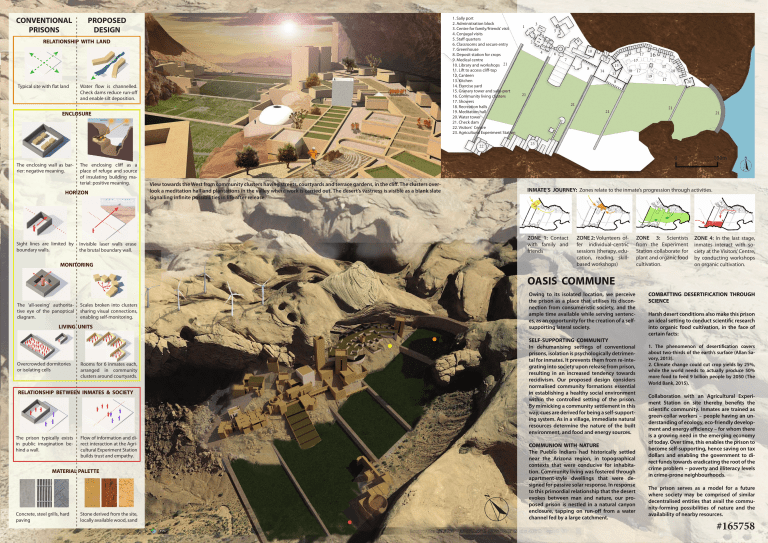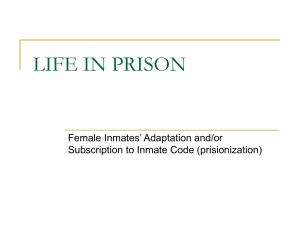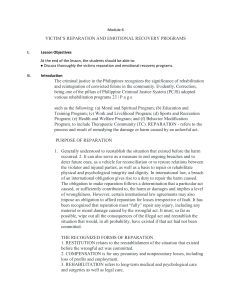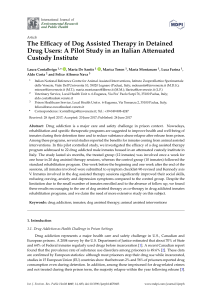
CONVENTIONAL PRISONS PROPOSED DESIGN 1. Sally port 2. Administration block 3. Centre for family/friends’ visit 4. Conjugal visits 5. Staff quarters 6. Classrooms and secure entry 7. Greenhouse 8. Deposit station for crops 9. Medical centre 10. Library and workshops 21 11. Lift to access cliff-top 12. Canteen 13. Kitchen 14. Exercise yard 15. Granary tower and sally-port 16. Community living clusters 17. Showers 18. Recreation halls 19. Meditation hall 20. Water tower 21. Check dam 22. Visitors’ Centre 23. Agricultural Experiment Station RELATIONSHIP WITH LAND summer winter Typical site with flat land Water flow is channelled. Check dams reduce run-off and enable silt deposition. ENCLOSURE summer winter 22 3 1 5 9 2 4 10 6 11 18 12 7 8 15 14 13 17 17 18 8 17 16 17 17 19 18 17 20 21 21 21 21 21 23 0 The enclosing wall as barrier: negative meaning. The enclosing cliff as a place of refuge and source of insulating building material: positive meaning. HORIZON Sight lines are limited by boundary walls. Invisible laser walls erase the brutal boundary wall. MONITORING View towards the West from community clusters having streets, courtyards and terrace gardens, in the cliff. The clusters overlook a meditation hall and plantations in the valley where work is carried out. The desert’s vastness is visible as a blank slate signalling infinite possibilities in life after release. 100m INMATE’S JOURNEY: Zones relate to the inmate’s progression through activities. ZONE 1: Contact with family and friends ZONE 2: Volunteers offer individual-centric sessions (therapy, education, reading, skillbased workshops) ZONE 3: Scientists from the Experiment Station collaborate for plant and organic food cultivation. ZONE 4: In the last stage, inmates interact with society at the Visitors’ Centre, by conducting workshops on organic cultivation. OASIS COMMUNE The ‘all-seeing’ authoritative eye of the panoptical diagram. Scales broken into clusters sharing visual connections, enabling self-monitoring. LIVING UNITS Overcrowded dormitories or isolating cells Rooms for 6 inmates each, arranged in community clusters around courtyards. RELATIONSHIP BETWEEN INMATES & SOCIETY The prison typically exists in public imagination behind a wall. Flow of information and direct interaction at the Agricultural Experiment Station builds trust and empathy. MATERIAL PALETTE Concrete, steel grills, hard paving Stone derived from the site, locally available wood, sand Owing to its isolated location, we perceive the prison as a place that utilises its disconnection from consumeristic society, and the ample time available while serving sentences, as an opportunity for the creation of a selfsupporting lateral society. SELF-SUPPORTING COMMUNITY In dehumanising settings of conventional prisons, isolation is psychologically detrimental for inmates. It prevents them from re-integrating into society upon release from prison, resulting in an increased tendency towards recidivism. Our proposed design considers normalised community formations essential in establishing a healthy social environment within the controlled setting of the prison. By mimicking a community settlement in this way, cues are derived for being a self-supporting system. As in a village, immediate natural resources determine the nature of the built environment, and food and energy sources. COMMUNION WITH NATURE The Pueblo Indians had historically settled near the Arizona region, in topographical contexts that were conducive for inhabitation. Community living was fostered through apartment-style dwellings that were designed for passive solar response. In response to this primordial relationship that the desert evokes between man and nature, our proposed prison is nestled in a natural canyon enclosure, tapping on run-off from a water channel fed by a large catchment. COMBATTING DESERTIFICATION THROUGH SCIENCE Harsh desert conditions also make this prison an ideal setting to conduct scientific research into organic food cultivation, in the face of certain facts: 1. The phenomenon of desertification covers about two-thirds of the earth’s surface (Allan Savory, 2013). 2. Climate change could cut crop yields by 25%, while the world needs to actually produce 50% more food to feed 9 billion people by 2050 (The World Bank, 2015). Collaboration with an Agricultural Experiment Station on site thereby benefits the scientific community. Inmates are trained as green-collar workers – people having an understanding of ecology, eco-friendly development and energy efficiency – for whom there is a growing need in the emerging economy of today. Over time, this enables the prison to become self-supporting, hence saving on tax dollars and enabling the government to direct funds towards eradicating the root of the crime problem – poverty and illiteracy levels in crime-prone neighbourhoods. The prison serves as a model for a future where society may be comprised of similar decentralised entities that avail the community-forming possibilities of nature and the availability of nearby resources. #165758






